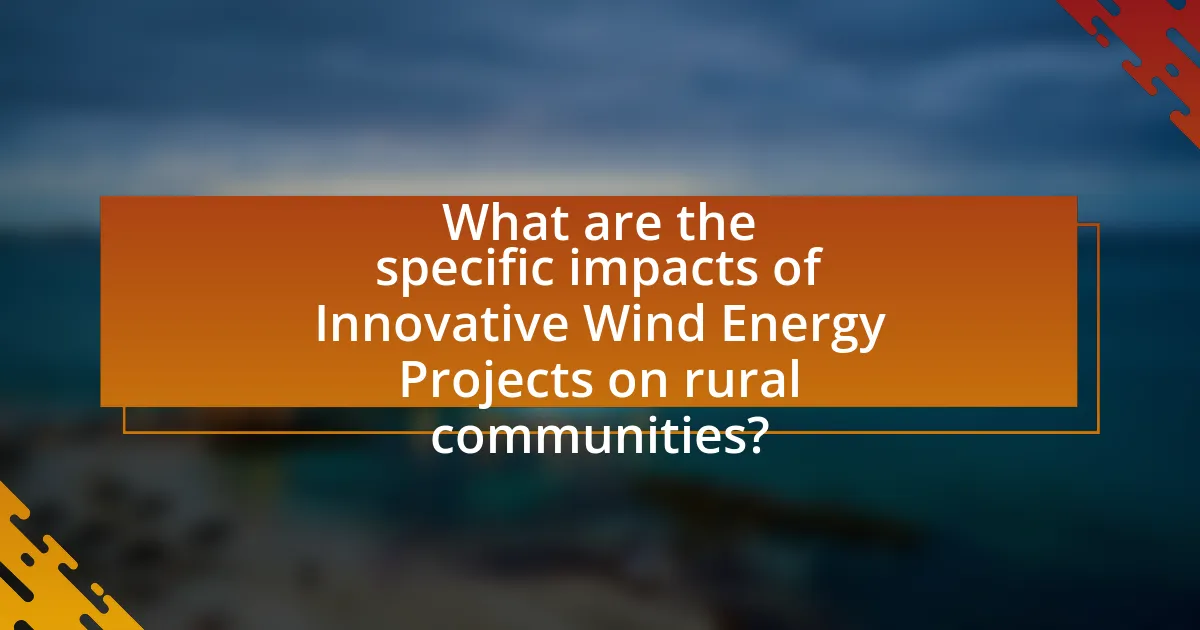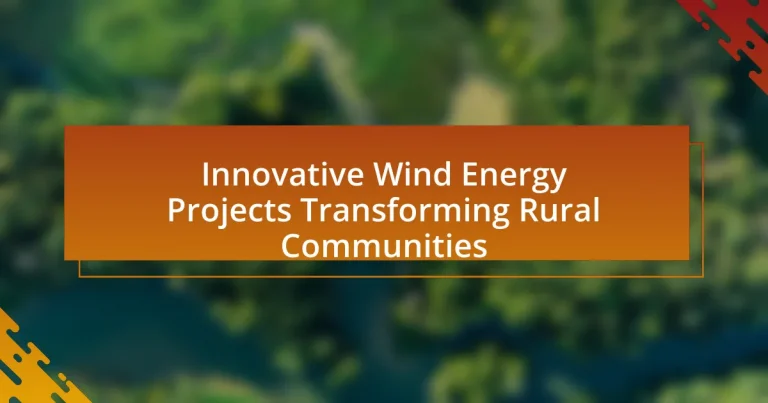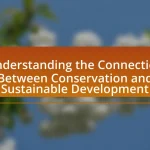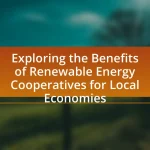Innovative wind energy projects are advanced initiatives that leverage cutting-edge technology to efficiently harness wind power, significantly impacting rural communities. These projects, such as vertical-axis wind turbines and floating wind farms, enhance energy production, create jobs, and stimulate local economies while contributing to renewable energy goals. The article explores the functioning of these projects, the technologies employed, their economic and social benefits, and the challenges they face, including regulatory issues and environmental concerns. Additionally, it highlights the importance of community engagement and local government support in the successful implementation of wind energy initiatives, ultimately showcasing their role in promoting sustainability and energy independence in rural areas.

What are Innovative Wind Energy Projects?
Innovative wind energy projects are advanced initiatives that utilize cutting-edge technology and creative approaches to harness wind power efficiently. These projects often incorporate features such as vertical-axis wind turbines, floating wind farms, and community-based energy systems, which enhance energy production and reduce costs. For instance, the Hornsea One project in the UK, the world’s largest offshore wind farm, generates 1.2 gigawatts of electricity, enough to power over a million homes. Such projects not only contribute to renewable energy goals but also stimulate local economies by creating jobs and promoting sustainable practices in rural communities.
How do Innovative Wind Energy Projects function?
Innovative wind energy projects function by harnessing wind power through advanced turbine technology and integrating renewable energy systems into local grids. These projects utilize high-efficiency turbines that convert kinetic energy from wind into electrical energy, often incorporating smart grid technology to optimize energy distribution and storage. For example, the Global Wind Energy Council reported that in 2022, wind energy accounted for 16.5% of global electricity generation, demonstrating the effectiveness of these projects in contributing to energy needs while reducing carbon emissions.
What technologies are utilized in these projects?
Innovative wind energy projects utilize technologies such as advanced wind turbines, energy storage systems, and smart grid solutions. Advanced wind turbines, equipped with aerodynamic blades and efficient generators, maximize energy capture from wind. Energy storage systems, including lithium-ion batteries, store excess energy generated during peak wind conditions for use during low-wind periods. Smart grid solutions enhance the integration of renewable energy sources, allowing for real-time monitoring and management of energy distribution. These technologies collectively contribute to the efficiency and sustainability of wind energy projects in rural communities.
How do these technologies impact energy production?
Innovative wind energy technologies significantly enhance energy production by increasing efficiency and reducing costs. These advancements, such as larger turbine designs and improved materials, allow for greater energy capture from wind resources. For instance, modern wind turbines can generate up to 50% more energy than older models due to their optimized blade designs and advanced control systems. Additionally, the integration of smart grid technologies facilitates better energy distribution and management, further maximizing the output from wind farms. This shift not only boosts local energy production but also contributes to a more sustainable energy landscape, as evidenced by the fact that wind energy accounted for approximately 8.4% of total U.S. electricity generation in 2020, reflecting its growing role in the energy mix.
Why are Innovative Wind Energy Projects important for rural communities?
Innovative wind energy projects are important for rural communities because they provide sustainable energy solutions while boosting local economies. These projects create jobs in construction, maintenance, and operation, which can significantly reduce unemployment rates in rural areas. For instance, a report by the U.S. Department of Energy indicates that wind energy projects can create approximately 1.5 jobs per megawatt installed, contributing to economic growth. Additionally, wind energy projects often lead to increased tax revenues for local governments, which can be reinvested in community services and infrastructure. This dual benefit of job creation and economic support underscores the critical role of innovative wind energy projects in enhancing the quality of life in rural communities.
What economic benefits do these projects provide?
Innovative wind energy projects provide significant economic benefits, including job creation, increased local revenue, and enhanced energy independence. These projects generate employment opportunities during both the construction and operational phases, with studies indicating that a single wind farm can create hundreds of jobs. For instance, the American Wind Energy Association reported that the wind industry supported over 100,000 jobs in the United States in 2020. Additionally, wind energy projects contribute to local economies through tax revenues and lease payments to landowners, which can bolster community services and infrastructure. Furthermore, by diversifying energy sources, these projects enhance energy independence, reducing reliance on fossil fuels and stabilizing energy costs for consumers.
How do they contribute to job creation in rural areas?
Innovative wind energy projects contribute to job creation in rural areas by establishing new employment opportunities in construction, operation, and maintenance of wind farms. These projects often require a skilled workforce for installation, which can create hundreds of temporary jobs during the construction phase. For example, a study by the U.S. Department of Energy found that wind energy projects can create approximately 1.17 jobs per megawatt installed, translating to significant local employment boosts. Additionally, ongoing operations and maintenance roles provide stable, long-term jobs, further enhancing economic stability in rural communities.
What challenges do Innovative Wind Energy Projects face?
Innovative wind energy projects face several challenges, including regulatory hurdles, financing difficulties, and technological limitations. Regulatory hurdles often arise from complex permitting processes and varying state and federal policies, which can delay project timelines and increase costs. Financing difficulties stem from the high initial capital required for development and the need for long-term investment stability, which can deter potential investors. Technological limitations include the need for advancements in turbine efficiency and energy storage solutions to optimize energy output and reliability. These challenges can hinder the successful implementation and scalability of innovative wind energy projects in rural communities.
What are the environmental concerns associated with these projects?
The environmental concerns associated with innovative wind energy projects include habitat disruption, noise pollution, and impacts on wildlife, particularly birds and bats. Habitat disruption occurs when land is cleared for wind turbine installation, potentially affecting local ecosystems. Noise pollution from turbine operation can disturb both wildlife and nearby residents. Additionally, studies indicate that wind turbines can pose a threat to avian species; for instance, the U.S. Fish and Wildlife Service reported that wind turbines are responsible for the deaths of approximately 140,000 to 328,000 birds annually in the United States. These factors highlight the need for careful planning and mitigation strategies in the development of wind energy projects.
How do regulatory issues affect project implementation?
Regulatory issues significantly impact project implementation by creating compliance requirements that must be met before proceeding. For instance, wind energy projects often face stringent environmental assessments, zoning laws, and permitting processes that can delay timelines and increase costs. According to the U.S. Department of Energy, regulatory hurdles can extend project development timelines by an average of 2 to 3 years, which can hinder the timely deployment of renewable energy solutions in rural communities. These delays can affect funding availability and stakeholder engagement, ultimately influencing the project’s success and sustainability.
How can communities engage with Innovative Wind Energy Projects?
Communities can engage with innovative wind energy projects by participating in planning processes, providing feedback, and forming partnerships with developers. Active involvement allows residents to voice their concerns and preferences, ensuring that projects align with local needs. For instance, community meetings and workshops can facilitate dialogue between developers and residents, fostering transparency and collaboration. Additionally, communities can explore financial investment opportunities, such as community-owned wind farms, which have been shown to enhance local economic benefits and increase public support for renewable energy initiatives. According to a study by the National Renewable Energy Laboratory, community engagement in renewable energy projects leads to higher acceptance rates and better project outcomes.
What role do local governments play in supporting these projects?
Local governments play a crucial role in supporting innovative wind energy projects by facilitating regulatory approvals, providing financial incentives, and engaging with local communities. They streamline the permitting process, which is essential for project development, ensuring compliance with environmental and zoning regulations. Additionally, local governments often offer tax breaks or grants to attract investment in wind energy, which can significantly reduce project costs. For instance, a report by the National Renewable Energy Laboratory highlights that local tax incentives can enhance the feasibility of wind projects, thereby promoting economic growth in rural areas. Furthermore, local governments act as intermediaries between project developers and residents, fostering community engagement and addressing concerns, which is vital for the successful implementation of wind energy initiatives.

What are the specific impacts of Innovative Wind Energy Projects on rural communities?
Innovative wind energy projects significantly impact rural communities by providing economic benefits, enhancing energy independence, and promoting environmental sustainability. These projects create jobs during both the construction and operational phases, with studies indicating that a single wind turbine can generate approximately 1.5 to 2.5 jobs per year in rural areas. Additionally, wind energy projects contribute to local tax revenues, which can be used for community services and infrastructure improvements.
Moreover, these projects reduce reliance on fossil fuels, leading to lower greenhouse gas emissions and fostering a cleaner environment. For instance, the U.S. Department of Energy reported that wind energy could reduce carbon dioxide emissions by up to 329 million metric tons annually. This shift not only supports local economies but also aligns with broader climate goals, making rural communities more resilient and sustainable.
How do these projects enhance energy independence?
Innovative wind energy projects enhance energy independence by generating local renewable energy, reducing reliance on imported fossil fuels. These projects enable rural communities to harness wind resources, leading to increased energy self-sufficiency. For instance, according to the U.S. Department of Energy, wind energy accounted for 8.4% of the total electricity generation in the United States in 2020, demonstrating its growing role in diversifying energy sources. By investing in wind energy infrastructure, communities can stabilize energy costs and create jobs, further solidifying their energy autonomy.
What are the implications for local energy prices?
The implications for local energy prices due to innovative wind energy projects are generally a reduction in costs for consumers. As wind energy becomes more prevalent, it often leads to lower electricity prices because wind power is one of the cheapest forms of energy generation, with costs dropping by 70% since 2009 according to the U.S. Department of Energy. Additionally, local wind projects can create competition in the energy market, further driving down prices. This shift not only benefits consumers through lower bills but also stimulates local economies by creating jobs and attracting investments.
How does energy independence affect community resilience?
Energy independence enhances community resilience by reducing reliance on external energy sources, which can be vulnerable to disruptions. When a community generates its own energy, particularly through renewable sources like wind, it can maintain power during crises, such as natural disasters or geopolitical tensions. For instance, communities that have adopted wind energy projects have reported increased stability in energy supply, leading to improved emergency preparedness and response capabilities. A study by the National Renewable Energy Laboratory found that local energy production can significantly lower energy costs and create jobs, further strengthening the economic foundation of the community. This self-sufficiency fosters a sense of security and promotes sustainable development, ultimately contributing to a more resilient community.
What social benefits arise from Innovative Wind Energy Projects?
Innovative wind energy projects provide significant social benefits, including job creation, community engagement, and enhanced local economies. These projects often lead to the development of new employment opportunities in construction, maintenance, and operation, which can reduce unemployment rates in rural areas. For instance, a study by the National Renewable Energy Laboratory found that wind energy projects can create approximately 1.17 jobs per megawatt installed, contributing to local workforce development. Additionally, these projects foster community involvement through local investment and decision-making processes, empowering residents and increasing social cohesion. Furthermore, the influx of revenue from wind energy can support local services and infrastructure, enhancing the overall quality of life for residents.
How do these projects foster community engagement?
Innovative wind energy projects foster community engagement by involving local residents in the planning and decision-making processes. These projects often establish community advisory boards that include local stakeholders, ensuring that their voices are heard and their concerns addressed. For instance, a study by the National Renewable Energy Laboratory found that when communities are actively involved in renewable energy projects, there is a 50% increase in local support for wind energy initiatives. Additionally, these projects create job opportunities and stimulate local economies, further encouraging community participation and investment in sustainable practices.
What educational opportunities do they create?
Innovative wind energy projects create educational opportunities by providing hands-on learning experiences in renewable energy technologies. These projects often involve local schools and community organizations, facilitating workshops, internships, and training programs focused on wind energy systems, sustainability practices, and environmental science. For instance, programs like the Wind for Schools initiative in the United States have successfully integrated wind energy education into curricula, allowing students to engage with real-world applications of science and engineering. This approach not only enhances students’ understanding of renewable energy but also prepares them for future careers in the growing green energy sector.
What are the long-term sustainability outcomes of these projects?
The long-term sustainability outcomes of innovative wind energy projects in rural communities include reduced greenhouse gas emissions, enhanced energy independence, and economic growth through job creation. These projects significantly lower carbon footprints by replacing fossil fuel energy sources with clean wind energy, contributing to climate change mitigation. For instance, a study by the National Renewable Energy Laboratory found that wind energy projects can reduce carbon dioxide emissions by up to 1.5 billion tons annually in the United States alone. Additionally, these projects foster local economies by creating jobs in construction, maintenance, and operation, with the American Wind Energy Association reporting over 100,000 jobs in the wind sector as of 2020. Overall, the integration of wind energy leads to sustainable development, benefiting both the environment and local communities economically.
How do they contribute to reducing carbon footprints?
Innovative wind energy projects contribute to reducing carbon footprints by generating electricity without emitting greenhouse gases. These projects harness wind power, which is a renewable energy source, to replace fossil fuels in electricity generation. For instance, according to the U.S. Department of Energy, wind energy has the potential to reduce carbon dioxide emissions by over 329 million metric tons annually, equivalent to the emissions from 70 million cars. By displacing fossil fuel-based energy, wind energy projects significantly lower overall carbon emissions, thereby mitigating climate change impacts.
What is their role in promoting renewable energy adoption?
Innovative wind energy projects play a crucial role in promoting renewable energy adoption by providing sustainable energy solutions that reduce reliance on fossil fuels. These projects not only generate clean electricity but also create economic opportunities in rural communities, enhancing local job markets and stimulating economic growth. For instance, according to the U.S. Department of Energy, wind energy has the potential to support over 600,000 jobs by 2050, demonstrating its significant impact on employment and energy transition. Additionally, these projects often involve community engagement and investment, fostering a sense of ownership and commitment to renewable energy initiatives among local residents.

What best practices can be adopted for successful Innovative Wind Energy Projects?
Successful innovative wind energy projects can be achieved by adopting best practices such as thorough site assessment, community engagement, and integration of advanced technology. Thorough site assessment ensures optimal wind resource evaluation, which is critical for project viability; for instance, using tools like LiDAR can enhance accuracy in measuring wind speeds. Community engagement fosters local support and addresses concerns, leading to smoother project implementation; studies show that projects with strong community involvement have higher acceptance rates. Lastly, integrating advanced technology, such as smart grid systems and energy storage solutions, enhances efficiency and reliability, as evidenced by projects that have successfully reduced operational costs and increased energy output.
How can communities effectively plan and implement these projects?
Communities can effectively plan and implement innovative wind energy projects by engaging stakeholders, conducting feasibility studies, and securing funding. Engaging stakeholders, including local residents, government officials, and energy experts, ensures that diverse perspectives are considered, fostering community support and collaboration. Conducting feasibility studies assesses the technical, economic, and environmental viability of the project, which is crucial for informed decision-making. Securing funding through grants, public-private partnerships, or community investment models provides the necessary financial resources to initiate and sustain the project. For instance, the American Wind Energy Association reports that community-driven projects often see higher success rates due to local buy-in and tailored solutions.
What strategies ensure community involvement and support?
Effective strategies for ensuring community involvement and support in innovative wind energy projects include transparent communication, stakeholder engagement, and educational initiatives. Transparent communication fosters trust by providing clear information about project goals, potential impacts, and benefits. Stakeholder engagement involves actively involving community members in the decision-making process, allowing them to voice concerns and contribute ideas, which has been shown to increase project acceptance. Educational initiatives, such as workshops and informational sessions, help demystify wind energy technology and its benefits, leading to greater community support. Research indicates that projects with strong community involvement experience higher levels of local support and successful implementation, as evidenced by case studies in rural areas where wind energy projects have been integrated with community needs and values.
How can project financing be secured?
Project financing can be secured through a combination of equity investment, debt financing, and government grants or incentives. Equity investment involves attracting investors who provide capital in exchange for ownership stakes, while debt financing can be obtained from banks or financial institutions that offer loans based on the project’s cash flow and collateral. Additionally, government grants and incentives, such as tax credits or subsidies, can enhance the financial viability of wind energy projects, making them more attractive to investors. For instance, the U.S. federal government offers the Investment Tax Credit (ITC) for renewable energy projects, which can significantly reduce the overall financing burden.
What lessons can be learned from existing Innovative Wind Energy Projects?
Innovative wind energy projects demonstrate that community engagement and local investment are crucial for successful implementation. Projects like the Hornsea One in the UK, which is the world’s largest offshore wind farm, show that involving local stakeholders can enhance acceptance and support, leading to smoother project execution. Additionally, these projects highlight the importance of technological advancements, such as floating wind turbines, which expand the potential for wind energy generation in deeper waters, as evidenced by the Hywind Scotland project. Furthermore, financial models that include profit-sharing with local communities can foster economic development and job creation, as seen in various cooperative wind farms across Europe. These lessons underscore the significance of collaboration, technology, and community benefits in the success of wind energy initiatives.
What case studies highlight successful implementations?
Successful implementations of innovative wind energy projects are highlighted by the case studies of the Shepherds Flat Wind Farm in Oregon and the Hornsea Project One in the UK. The Shepherds Flat Wind Farm, with a capacity of 845 megawatts, became operational in 2012 and significantly contributed to local job creation and economic growth, generating over $1 billion in investments. Similarly, the Hornsea Project One, which began operations in 2020, is the world’s largest offshore wind farm, with a capacity of 1.2 gigawatts, providing clean energy to over one million homes and creating thousands of jobs in the region. These case studies demonstrate the positive impact of wind energy projects on rural communities through economic development and sustainable energy production.
What common pitfalls should be avoided?
Common pitfalls to avoid in innovative wind energy projects include inadequate community engagement, which can lead to local opposition and project delays. Engaging with the community early and consistently fosters trust and addresses concerns, as evidenced by studies showing that projects with strong local support are more likely to succeed. Another pitfall is underestimating the importance of thorough site assessments; failing to conduct comprehensive environmental and technical evaluations can result in costly operational issues later. Research indicates that projects with detailed feasibility studies have a higher success rate, highlighting the necessity of this step. Additionally, overlooking regulatory compliance can lead to legal challenges and project halts, as seen in various case studies where non-compliance resulted in significant financial losses.
What are the future trends in Innovative Wind Energy Projects?
Future trends in innovative wind energy projects include the integration of advanced technologies such as floating wind turbines, which allow for deployment in deeper waters, and the use of artificial intelligence for optimizing energy production and maintenance. These advancements are expected to enhance efficiency and reduce costs, making wind energy more accessible. For instance, the global floating wind market is projected to grow significantly, with estimates suggesting a capacity increase from 0.1 GW in 2020 to over 15 GW by 2030, according to the International Energy Agency. Additionally, community-based wind projects are gaining traction, empowering rural communities to take ownership of energy production, thereby fostering local economic development and sustainability.
How is technology evolving in the wind energy sector?
Technology in the wind energy sector is evolving through advancements in turbine design, energy storage solutions, and digitalization. Modern turbines are now larger and more efficient, with rotor diameters exceeding 150 meters, which allows for greater energy capture even at lower wind speeds. Additionally, innovations in energy storage, such as lithium-ion batteries and pumped hydro storage, enhance the reliability of wind energy by balancing supply and demand. Digital technologies, including IoT and AI, optimize turbine performance and predictive maintenance, leading to reduced operational costs and increased energy output. These advancements collectively contribute to the growing viability and integration of wind energy in rural communities, supporting sustainable development and energy independence.
What innovations are on the horizon for rural energy solutions?
Innovations on the horizon for rural energy solutions include advanced wind energy technologies, such as vertical-axis wind turbines and floating wind farms. These technologies are designed to optimize energy generation in diverse rural landscapes, making wind energy more accessible and efficient. For instance, vertical-axis wind turbines can operate effectively in turbulent wind conditions, which are common in rural areas, while floating wind farms can be deployed in deeper waters, expanding the potential for energy generation. According to the Global Wind Energy Council, the global wind power capacity is expected to reach 1,200 GW by 2025, indicating a significant shift towards renewable energy sources in rural settings.


